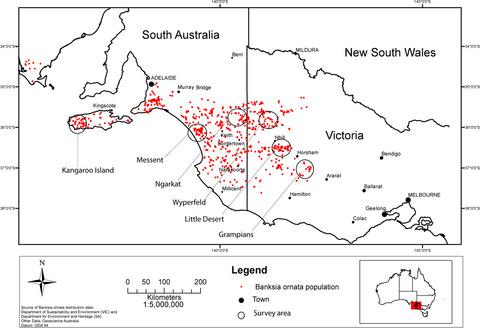当前位置:
X-MOL 学术
›
Austral Ecol.
›
论文详情
Our official English website, www.x-mol.net, welcomes your
feedback! (Note: you will need to create a separate account there.)
Does intraspecific variation in demography have implications for fire management of an obligate‐seeder shrub across its geographic range?
Austral Ecology ( IF 1.6 ) Pub Date : 2020-11-25 , DOI: 10.1111/aec.12981 John W. Morgan 1, 2 , Michael A. McCarthy 3 , Emily Willocks 1, 4
Austral Ecology ( IF 1.6 ) Pub Date : 2020-11-25 , DOI: 10.1111/aec.12981 John W. Morgan 1, 2 , Michael A. McCarthy 3 , Emily Willocks 1, 4
Affiliation

|
Predicting changes in the abundance of species over time is a central goal of conservation ecology. Typically, demographic data are used to parameterise models which describe population dynamics. Vital rates of plants vary across a species’ distribution, yet most demographic estimates are spatially constrained. Banksia ornata (Proteaceae), a widespread serotinous obligate‐seeding shrub in southern Australia, has previously had a fire management model developed based on demographic data derived from a chronosequence in one part of the species’ range. We asked: are demographic data collected from a limited geographic range robust for developing population dynamic models that are applied across the broader species’ range? How much variation exists in the demography of species across their range and does this matter for estimating fire return intervals necessary for species persistence? We examine site‐to‐site variation in the pyrodemography of six populations of B. ornata encompassing its geographic range. We documented changes in population density, time to first reproduction and canopy seed bank accumulation in stands varying in age from 0.5 to 55 years. We model year of maximum seed production on demographic parameters such as population starting density and survival rate. Density, primary juvenile period, rates of mortality and seed bank accumulation varied across populations. Primary juvenile period varied across populations (from 6 to <20 years), while time to maximum seed production was estimated to take 34–39 years after fire. Hence, the fire intervals that correspond to minimising extinction risk (due to variation in primary juvenile periods) diverge moreso among populations than the fire intervals that produce (on average) the highest maximum seed production with respect to time since fire. Demographic data collected at different locations in a species’ range are likely valuable for building realistic species response models to disturbance, providing underlying assumptions about key transitions, such as mortality rate, are made explicit.
中文翻译:

人口统计学的种内差异是否会对整个地理范围内的专性播种灌木的火灾管理产生影响?
预测物种丰富度随时间的变化是保护生态学的主要目标。通常,人口统计数据用于参数化描述人口动态的模型。植物的生命率因物种的分布而异,但是大多数人口统计数据在空间上都受到限制。山龙眼(Proteaceae)是一种在澳大利亚南部广泛分布的具血清素的专性种子灌木,以前曾根据根据物种范围一部分时间序列得出的人口统计数据开发了一种火管理模型。我们问:从有限的地理范围内收集的人口统计数据是否对建立适用于更广泛物种范围的种群动态模型具有鲁棒性?物种的人口统计数据在整个范围内存在多少变化,这对于估计物种持续存在所需的回火间隔有关系吗?我们检查了六个种群的B. ornata的热释电图在站点间的差异。涵盖其地理范围。我们记录了年龄在0.5至55岁之间的林分中种群密度,首次繁殖时间和冠层种子库积累的变化。我们根据人口统计学参数(例如种群起始密度和成活率)对最大种子产量的年份进行建模。密度,初级未成年期,死亡率和种子库积累因人群而异。各个种群的初级少年时期各不相同(从6年到<20年),而估计达到最大种子生产的时间需要在大火后34-39年。因此,对应于使灭绝风险最小化的火灾间隔(由于初级幼年期的变化)在种群之间的差异要大于火灾间隔(就火灾以来(平均)而言)产生最高最大种子产量的火灾间隔。
更新日期:2020-11-25
中文翻译:

人口统计学的种内差异是否会对整个地理范围内的专性播种灌木的火灾管理产生影响?
预测物种丰富度随时间的变化是保护生态学的主要目标。通常,人口统计数据用于参数化描述人口动态的模型。植物的生命率因物种的分布而异,但是大多数人口统计数据在空间上都受到限制。山龙眼(Proteaceae)是一种在澳大利亚南部广泛分布的具血清素的专性种子灌木,以前曾根据根据物种范围一部分时间序列得出的人口统计数据开发了一种火管理模型。我们问:从有限的地理范围内收集的人口统计数据是否对建立适用于更广泛物种范围的种群动态模型具有鲁棒性?物种的人口统计数据在整个范围内存在多少变化,这对于估计物种持续存在所需的回火间隔有关系吗?我们检查了六个种群的B. ornata的热释电图在站点间的差异。涵盖其地理范围。我们记录了年龄在0.5至55岁之间的林分中种群密度,首次繁殖时间和冠层种子库积累的变化。我们根据人口统计学参数(例如种群起始密度和成活率)对最大种子产量的年份进行建模。密度,初级未成年期,死亡率和种子库积累因人群而异。各个种群的初级少年时期各不相同(从6年到<20年),而估计达到最大种子生产的时间需要在大火后34-39年。因此,对应于使灭绝风险最小化的火灾间隔(由于初级幼年期的变化)在种群之间的差异要大于火灾间隔(就火灾以来(平均)而言)产生最高最大种子产量的火灾间隔。











































 京公网安备 11010802027423号
京公网安备 11010802027423号